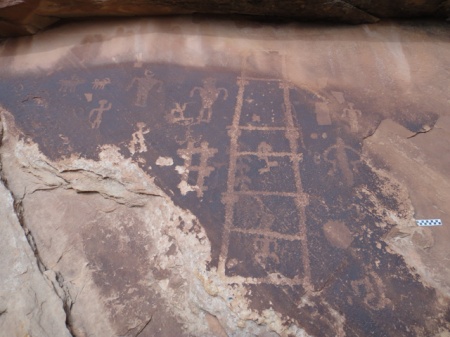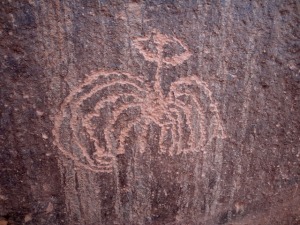I’ll begin with one of my favorite statements lately- there just isn’t enough time in the day to do it all. As luck would have it, I did find time to get out over spring break, and of course I have planned to write something about it. So here we go, to summarise: I managed 12 days of hiking and saw some amazing sights, as always. Weather was great, excepting the usual spring winds that always come up. There were birds- lots of raptors this trip, including many bald eagles. Reptiles were out- lizards of many types and one very cold rattlesnake that didn’t move throughout an entire day. And the rock art- there were so many amazing panels and elements and discoveries within panels that it constitutes a blog in itself. But beyond all that, this trip was unique as it was my first spring break alone in about 10 years. My usual sidekick, my son, had too many prior engagements to come along. I made the most of my time alone, enjoying the Utah sunrises, sunsets, evening fires, and every minute in between.
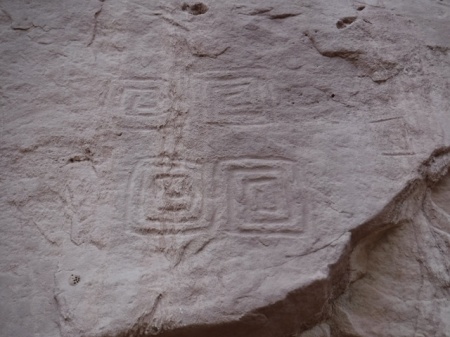
A unique set of four square spiral petroglyphs. Do they represent the seasons? I would be curious to revisit this site during the seasonal changes to see if there are any types of solar alignments.
One thing that struck me this trip beyond all else was the amount of time we spend planning, and where that planning can sometimes get us. Don’t get me wrong- planning can be everything, it can mean the difference between a fun, memorable trip and a disaster. But there are times that planning can get in the way of our adventures. Planning can hold us back, it can hold back the explorer in us and stifle the sense of accomplishment, the sense of discovery that we seek out there in the bush.
We live in an overstimulated world with just too much information flowing around us, in our heads and readily at hand. One of the reasons I go into the desert is to escape all that. And I don’t want to bring along a bunch of data- on anything. I want to walk and see and hear things, feel the sand under my boots or under my bare feet, wonder about what is around the next corner. I don’t want to look for the next thing I am supposed to find at a certain distance from a certain point. Where is the fun in that? For me, that is too much like everything else in life these days- click a link and it’s all there. That is decidedly not what wilderness is about for me.
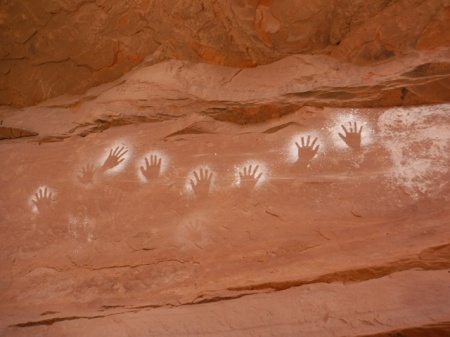
White hands- one of my favorite pictographs, and one of the first I “discovered” in southeast Utah about 20 years ago. I visited them again on this trip.
I have never been one to plan an entire trip, hour by hour, water point to water point, camp site to camp site. I know that people do this. There are guide books that do it for you. This is one of the very reasons I don’t use guide books, other than for very general information. My favorite writer of guides, as I have expressed over the years, is Michael Kelsey. He gives clear, concise, to-the-point information, and not much more. That is all I want- mileage to the trailhead for example, if I don’t choose my own, or maybe data on the best way to climb out of a canyon that everyone says cannot be climbed out of. Kelsey’s books are the place for something like that. After that, it is all up to me.
Moving on from my philosophy of wilderness travel back to civilisation, I always end my trips in Moab. I like to mention my favorite local businesses, in support of the community there. Moab Gear Trader has recently moved into the space above their original store. They have so much used and new gear now that it’s easy to find something you can use. I have an account there, and usually drop gear to sell on every trip. You don’t have to live locally to do this- give them a call to see if they may want your used gear. And if you can’t find what you need there, just down the street is Gearheads, where you will find whatever it is you forgot to bring along. There was a time when I would worry about that piece of gear that I inadvertently left behind, but not any more. Between Moab Gear Trader and Gearheads, I know I will find what I need.
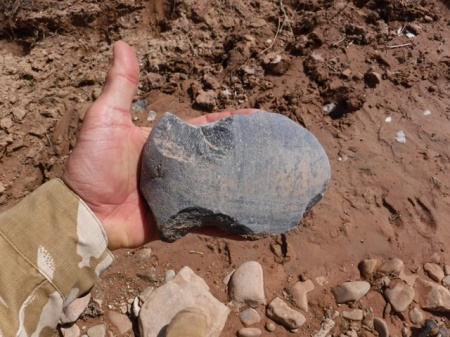
Found in a wash bottom- one large axe head. They artifact had signs that it had been in the wash for some time, and also plenty of use wear. It was made from a perfectly shaped, very flat river cobble.
Gear is good, but we can’t leave out food and coffee to make us happy. Moonflower Coop, on 100 North right off of Main Street, recently completed a major renovation and it is not to be missed. They even have a seating area now at their deli, where they offer fresh salads, sandwiches, soups, and much more. They are right across the street from Moab Coffee Roasters, one of our favorites. Need a backup bike tube with your coffee? Be sure to visit Moab Classic Bikes on Center Street for both- yes, there is a coffee shop in the bike store. Very convenient!
Our next trip is planned for the end of May- a couple of weeks in the Hanksville area. We are planning, if weather and water levels permit, to walk the Dirty Devil River. No dragging the boat this year! In the meantime, there is plenty more information on desert travels in southern Utah at DesertExplorer.us.



 Posted by desertexplorer
Posted by desertexplorer 